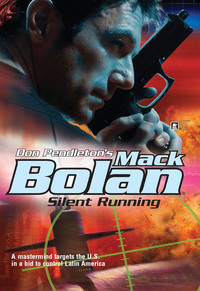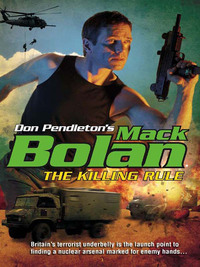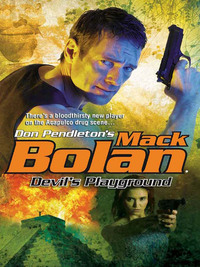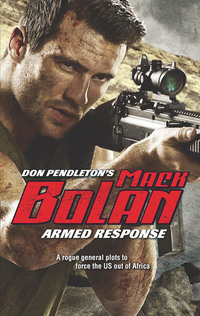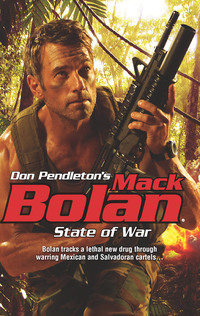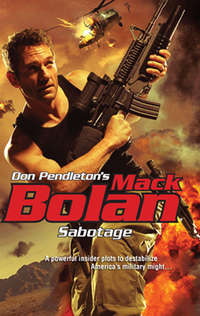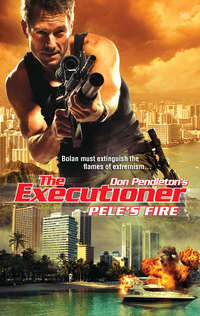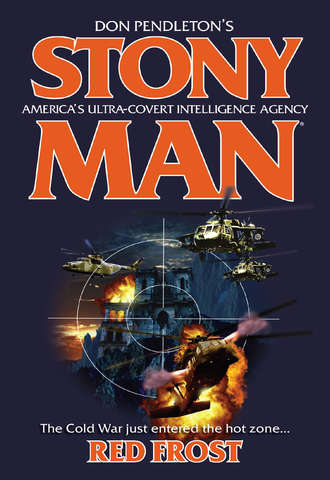
Полная версия
Red Frost
The other two girls were stumbling along fifteen feet ahead. “Carry them!” he yelled over his shoulder.
His tone of voice and the gun in his hand left no room for discussion.
Two of the freed men stopped and quickly gathered up the pregnant girls, carrying them as they ran.
Blancanales closed on the trailers with caustic smoke flowing from the burning trucks swirling around him, stinging his eyes. The Light Fifty boomed again, and a car horn started to blow. He didn’t look back.
On the far side of the single-wides, Blancanales put down the girl. Her baby face was contorted with fear, but she just stood there, a doe in the headlights. She didn’t move even when he turned away. As he roughly ushered the others forward, the car horn stopped and the gunfire dwindled, as well. Someone started yelling from the meth lab. He couldn’t make out the words.
“Get down! Quick!” Blancanales shouted in Spanish, shoving the prisoners from behind. “On the ground! Cover your heads!”
Then time ran out.
THE METH SLAVES HIDING under burning truck 2 didn’t budge at Lyons’s urging. They stared back at him as if he were the bogeyman. The unintelligible shouting of a huge guy in a ski mask with two autoweapons didn’t do much to instill confidence and trust.
Lyons slung one of the machine pistols, then lunged forward, grabbing the nearest laborer by the arm. “The rest of you, come on!” he yelled. “You can’t stay under there! You’re all gonna die if you do!”
The raggedy laborer went limp on him. Deadweight in the dirt. Lyons hauled him out from under the chassis anyway, but as soon as he let go, the man turned and crawled right back.
The heat from the engine fire was getting worse. So was the oily smoke. The situation was flat-out impossible. There was nothing Lyons could do. In the end, self-preservation had to take precedence over rescue.
“Shit!” he snarled in frustration as he bailed. High-kicking, he raced back the way he had come, around the last truck in line, past the end of the meth lab and the corner of the shotgun shack, heading for the irrigation canal. A single gunshot from the Barrett rang out, followed by a massive, billowing explosion. Behind him, at the edges of his peripheral vision, the world turned a brilliant orange. Holding the machine pistols overhead, he jumped for the irrigation ditch. In midair, icy cold slammed his back, penetrating right through his blacksuit. A fraction of a second later the overloaded nerves correctly registered the sensation as heat.
Skin-blistering heat.
As he plunged into the ditch water, the explosion’s concussive force pitched him forward, face first toward the far bank.
SCHWARZ NEEDED ONLY ONE API round to send the whole narco compound straight to hell.
He put the M-8 incendiary slug through the middle of one of the fifty-five-gallon chemical barrels lined up in front of the meth lab. On impact, there was an intense white flash. A fraction of a second later, with a resounding boom the targeted drum became a forty-foot-wide, forty-foot-high ball of flame. The initial explosion set off a chain reaction with the other drums and with the cargo container. In a stunning instant, the raw materials of meth mass production—acetone, toluene, ether—were transformed into nothing less than a napalm bomb.
At the center of the seething fireball, the cargo container flew apart; the detonation’s shock wave blew off the roof of the tumbledown shack and rocked the single-wide trailers off their cinder-block foundations. As a churning black mushroom cloud erupted from the center of the explosion, the heaviest debris began raining down, a torrent of unrecognizable metallic junk falling through the flaming mist.
Like a string of massive firecrackers, the gas tanks and cargo boxes of the rental trucks exploded one by one.
The initial blast sent the trailer nearest to the lab sliding off its foundation. With a sickening screech it dominoed into the second single-wide and knocked it loose, as well. For an instant the sky overhead was the color of flame.
“Stay down!” Blancanales howled as one of the forced workers broke for the open fields behind them. “Cover your heads!”
The runner got maybe twenty feet before he was cut down by a cartwheeling, six-foot chunk of corrugated sheet steel. Its ragged edge caught him square in the back and pancaked him into the dirt.
Lighter and lighter materials pelted the field, then came a rain of fine, choking dust. Mixed in were burning bits of green paper, the contents of the black duffel. The meth lab had become a smoking hole in the ground.
Dripping wet, Carl Lyons appeared through the drug-profit confetti, a muddy smudge on the forehead and cheek of his ski mask.
Glancing at the surviving slaves scattering in all directions, Blancanales said, “What do you think, should we call INS to pick them up?”
“Not our job,” Lyons replied. “Besides, these people have been through enough for one day. Let’s get the hell out of here.”
The two men quickly dragged the limp bodies out of the blackened, blistered SUV and brushed some of the glass off the leather seats. Lyons then drove it on two flats across the field where Schwarz waited beside the combine. As he rode in the back with the Barrett, Schwarz looked up at the gore sprayed over the headliner and dash and said, “Man, I really made a mess of this ride, didn’t I?”
Lyons flattened the gas pedal and the SUV bounded forward, porpoising over the furrows and slewing through the soft, tilled earth. The designated landing zone was a half mile away from the killzone, just in case the mop-up was incomplete.
It wasn’t.
When Lyons stopped the Lexus, nothing but rims were left on the driver’s side. At once a gray-and-red helicopter popped up out of the north, swinging in very low and very fast. Because of the ongoing federal airspace surveillance, Jack Grimaldi’s landing was touch-and-go. The second the skids struck dirt, Able Team piled in.
No time for small talk.
A half-smoked, unlit cigar clenched in his teeth, Grimaldi vaulted the chopper off the ground with a sickening lurch, then wheeled it around 180 degrees, dropping to fencepost height and really putting the hammer down.
“DEA closing in?” Blancanales asked as he snapped into a safety harness.
“Are you kidding?” the deeply tanned pilot growled over his shoulder. “The Feds’ mouths are still hanging open.”
“Then where’s the goddamn fire?” Lyons asked.
“Two hours away. Just got word from the Farm on the secure line. Shit has hit the fan over on the coast…this one’s big time.”
CHAPTER TWO
Stony Man Farm, Virginia,
9:49 a.m. EDT
Fourteen minutes after the Russian sub ran aground on Ediz Hook, eight minutes after receiving a frantic hot-line call from the White House, five minutes after Jack Grimaldi was notified of the situation via secure scrambled channel, Hal Brognola was still staring at the satellite feed replay on the flat-panel wallscreen. He couldn’t help himself. The other members of the Stony Man team—mission controller Barbara Price, weapons specialist John “Cowboy” Kissinger, and the elite cyber squad of Aaron “the Bear” Kurtzman, Huntington Wethers, Akira Tokaido and Carmen Delahunt—were all having the same reaction.
Recurring disbelief.
The image on the screen was that shocking.
The bow of the huge black foreign warship jutted out of U.S. waters, its submerged propeller churning up plumes of froth. In the background, not one hundred yards away, stood the little orange Coast Guard air station hangar at the tip of Ediz Hook.
A second flat-panel wallscreen was filled with jerky live-feed video with sound from a circling Coast Guard helicopter. A dense pillar of smoke boiled up from the sub’s sail, drifting lazily south over the little mill town.
Brognola knew that at that moment additional Coast Guard and Navy helicopters from Neah Bay and Whidbey Island, respectively, were en route, as was the emergency-nuclear-response unit from sub base Bangor on Hood Canal. ETA on the ENR team was five more minutes. Meanwhile, scrambled A-6s from Whidbey Naval Air Station were already screaming low over the scene, sealing off the airspace.
As the Coast Guard video zoomed in tight on the sub’s stern and the churning prop, the head Fed couldn’t help but grimace. Nuke-powered boat running full tilt half out of the water, smoke pouring out amidships. Brognola wasn’t the only one who visualized dire consequences.
“For pete’s sake, why doesn’t the crew shut down the engines!” Barbara Price exclaimed.
“It’s got to be hotter than hell in there,” Hunt Wethers said. The African American, former Berkeley cybernetics professor gestured at the screen with the mouthpiece of his unlit pipe and said, “Why hasn’t anyone bailed from the sub?”
“Maybe they can’t get out,” Akira Tokaido suggested. “Exit routes all blocked…”
“Actually, the damage doesn’t look that bad,” Kissinger told the young Japanese American. “Like a lot of the Russian subs, the hull is probably made up of two layers, an inner and outer skin with six feet of crush space between them, so even grounded there might not be a full breach. I’ve never seen that design configuration before, but the ship is similar to the Bars class attack subs—something just over three hundred feet in length. There’s got to be at least thirty or forty crew on board.”
“Is it carrying nukes?” Delahunt asked. The redheaded former FBI agent and divorced mother of three put her finger right on the hot button.
“It’s an SSN, not a ballistic-missile sub,” Kissinger said, “but who knows what armament’s on board.”
“There’s a nuclear reactor, though,” Brognola countered.
“Actually there are probably two pressurized water reactors,” Kissinger corrected him.
“They are the critical issue at this point,” Brognola said. “Something’s already burning inside.”
Kissinger immediately picked up the thread. “If sub’s reactors catch fire,” he said, “their nuclear material will be released into the surrounding air and water. If there are nukes onboard, they won’t detonate from the heat, but their payloads will be dispersed.”
Aaron Kurtzman pivoted his wheelchair to face the others. “With strong tides running all the way to Seattle and Tacoma,” he said gravely, “the scale of the disaster would be unthinkable.”
“And for all intents and purposes, irreparable,” Wethers added.
The last comment was met by silence.
“The ENR unit is going to have to work quickly,” Kissinger said. “They’ve got to get inside the ship, put out the fires and shut down propulsion. After that, they can start a full damage assessment, structural and nuclear. If it turns out the sub can be safely towed off the point, they have to identify and secure all hull breaches by sealing internal bulkhead doors.”
“Do you think they’ll meet resistance from the crew?” Price asked.
“A separate SEAL team will deal with that,” Brognola answered for him. “They’ll handle the initial boarding and pacification, if necessary.”
The scene on the live-feed video suddenly shifted as the Coast Guard chopper wheeled to the north, flying around the edge of the smoke plume. The Hook’s narrow road curved past the Daishowa pulp mill before joining up with the mainland at the head of the bay. Five Port Angeles police cars were parked across the two-lane road with lights flashing. On the far side of the cruisers, the town’s entire complement of fire engines and ambulances sat idling, waiting for an all-clear so they could approach the stranded ship.
Traffic had already started to back up on the road behind the EMTs. It wasn’t just night-shift mill hands who’d deserted their posts for a look, or morning-shift workers waiting around for their day to begin. The resounding impact of the sub’s grounding had awakened most of the city’s population. From virtually every street corner on the hillsides above the bay, if not every kitchen window, the black ship was a visible blot on the landscape. In response, whole families had piled into their cars and vans, heading for the Hook in hopes of getting a closer view of the spectacular accident. As a result, the streets of Port Angeles’s tiny downtown were gridlocked, bumper to bumper. The smarter folks, the few who could distinguish imminent danger from free circus, were already streaming out of town in the other direction, on Highway 101.
The Coast Guard helicopter veered to the left and swung out over Port Angeles Bay. Its video feed revealed an armada of small and large boats racing from the mainland shore, all making a beeline for the Hook and the object of curiosity. The chopper pilot flew low and fast on an intercept course.
Stony Man’s wallscreen filled with a bird’s-eye view of the sixteen-foot runabout leading the pack. Its lone passenger was hanging on to the windshield with one hand, trying to use a digital camcorder with the other. Rotor wash whipped a ring of froth around the little boat, forcing the photographer to sit down. It blinded the boat’s pilot, and he backed off on the throttle.
Someone in the hovering aircraft, presumably the pilot or copilot, addressed the oncoming fleet through a loud-hailer. “Return to the harbor at once! For your own safety, return to shore! This is a restricted area!”
A few of the boaters immediately turned back; however, most ignored the command. There was obviously no way to enforce it. There were too many boats and the helicopter was unarmed.
“Where’s Homeland Security?” Delahunt said.
“Basically, you’re looking at it,” Kissinger replied. “There’s a Coast Guard cutter on station out at the entrance to the Strait of Juan de Fuca. But that’s almost two hours away. A handful of part-time DHS personnel man the international border where the ferry from Canada docks.”
“No way anyone could have foreseen something like this,” Brognola said emphatically. “This should never have happened.”
“Okay, John,” Price said, turning to the Farm’s weapon systems analyst, “give us your best guess. How is what we’re looking at even possible?”
“The U.S. antisubmarine—ASW—warfare program consists of layered defenses using different technologies,” Kissinger said. “Some of them are cold war era, some more recent. There’s SURTASS, surveillance towed array system. RDSS, rapidly deployable surveillance system. LRMP, long-range marine patrol, armed with magnetic-anomaly detectors. There’s radar and stationary directional and nondirectional sonar buoys. A more recent development is UDAR, a satellite-mounted laser aimed at the sea. It reflects off and reveals a submerged sub’s wake.”
“Sounds pretty solid to me,” Delahunt said.
“Yeah, but you’ve got to keep in mind that the surveillance is covering a vast area above and below the surface. For decades, our ASW people have been monitoring the sub bases in the Sea of Okhotsk, the Barents Sea, the Kola Peninsula and Gremikha. At these choke points, Russian subs can be identified and tracked by satellite and by U.S. sub patrols on station. Past the choke points, in the open ocean, the technological net has holes.”
“What do you mean by ‘holes’?” Tokaido asked.
“There’s an overlap of radar bounce-back, called a shadow or convergence zone, that creates a blind channel thirty-three nautical miles wide. Subs can hide in it and evade detection. The Russians have perfected the welding of titanium for their sub hulls, which makes them harder to locate through magnetic anomaly. Some of their ships can make forty-two knots submerged to three thousand feet.”
“Our ships are fast, too, and our people are absolutely top notch,” Price countered. “In fact, there’s no comparison.”
“No argument there,” Kissinger said. “Equipment and personnel aren’t the problem. It’s mission creep. Between the end of the cold war and the start of the second Iraq war, our fleet’s patrol duties were reevaluated and redefined. The hostile threat from Russia was downgraded, and some of our subs were taken off SSBN patrol and converted into platforms for launching conventionally armed missiles against military targets in the Near East. Fewer patrols means bigger holes.”
“Sorry, it still doesn’t compute,” Kurtzman said. “Harder to detect isn’t the same as undetectable.”
“I can’t explain why UDAR and resonance scatter didn’t pick up that ship well out to sea,” Kissinger said. “At this point there’s not enough data to know what happened. After Able Team arrives on scene we’ll have more to work with.”
“Their ETA isn’t until 9:15 a.m., PDT,” Brognola said. “We can’t just sit here and twiddle our thumbs. From what the President told me, the Russians are denying all knowledge of the sub or the nature of the incursion. They are denying it’s even their ship.”
The chief of the cyberunit spoke up. “Hunt and Carmen, let’s search the DOD’s secure database and try to ID the ship from the hull configuration. Pull up everything about sub designers and shipyards. I’ll check the satellite surveillance library and backtrack all departures from the known SSBN and SSN bases. Maybe we can figure out where this sub came from and when it left its home port.”
“We don’t know its route after it entered the Strait of Juan de Fuca, either,” Tokaido said. “I’ll go over the sat-feed system replays, second by second. That might tell us something about the sub’s mission.”
“Did the President make it clear why he was calling in Able Team on this?” Price asked Brognola.
“He wants all means at his disposal.”
“Able can do things the white ops can’t,” Wethers said.
“Like shoot reporters?” Delahunt joked.
“Too many talking heads, not enough bullets,” Kissinger said.
“John’s right,” Kurtzman said. “This is going to be a three-ring circus. You can bet news helicopters from Seattle are already en route. There’s no way to stop the media even if the Navy seals off the airspace. You can see that wreck from Vancouver Island in Canada, twenty-six miles away.”
“Able’s mission isn’t a cover-up,” Brognola told his people. “The President wants someone on the ground who can cut through the bullshit. He anticipates problems with overlapping responsibilities in this crisis.”
“Turf wars between Homeland Security, FBI, CIA, Navy, Coast Guard and state and local police?” Delahunt asked.
“You got it,” Brognola said.
“Under the circumstances, Able Team is bound to step on some toes,” Kurtzman said. “And they never step lightly.”
“The President doesn’t care about that. He wants the job done fast, and he wants it done right.”
Tokaido pointed at the wallscreen. “Here come the good guys,” he said.
Live-feed video showed four Navy helicopters descending on the Hook in tight formation. As soon as their wheels touched the Coast Guard air station’s landing pad, men in black jumped from the bay doors.
They hit the ground running.
CHAPTER THREE
Port Angeles, Washington,
7:02 a.m. PDT
As Commander Reuben Starkey and his ENR crew hurriedly off-loaded gear from their helicopter onto a pair of handcarts, the thirty-two-man SEAL team closed on the grounded sub with autoweapons up and ready. Half of the commando unit took up bracketing-fire positions along the Hook’s riprap, the rest leapfrogging each other to the underside of the looming black bow.
A tight, excited voice crackled in Starkey’s communication headset. It was the SEAL team leader, Captain Bradford Munsinger. “ENR, we’ve got severe crush damage forward,” he reported. “Background rads are within acceptable limits. We’re going up.”
Commander Starkey and his four subordinates stopped shifting equipment; they turned and watched the SEALs in rapt silence. Like Starkey, the others were all career Navy men. In the seven years they had worked together at sub base Bangor, they had handled various highly classified and potentially catastrophic nuclear emergencies in Puget Sound, along the western seaboard and in the Pacific theater. Despite that experience and expertise, Starkey found himself cotton-mouthed by what lay before them this morning.
Spitless.
As far as Starkey was concerned, the unheard-of incursion into U.S. territorial waters and breach of national defense systems took a backseat to more immediate and pressing problems. A little slice of America, the Olympic Peninsula mill town, stood utterly defenseless behind them. The nuke-powered vessel was on the beach and on fire. There was no way of telling what kinds of armament the ship was carrying. The commander could feel the vibrations of the rampaging engines and prop through the airstrip’s tarmac, even though the submarine was three hundred yards away.
Stepping out from under the protection of the hull, the SEALs took turns firing grappling hooks onto the deck, more than four stories above them. With the sub’s sail and escape-trunk hatches zeroed in by flanking fire, black-gloved men shouldered automatic weapons and scrambled up the knotted ropes. The first SEAL to land boot soles on the steeply slanted deck was Bradford Munsinger. Following his hand signals, the others covered the forward and aft escape hatches point-blank with their 9 mm H&K machine pistols.
“Radiation is still within acceptable limits,” Munsinger announced into his mike. “Come on up, boys, and join the party.”
ENR stayed put. He wasn’t talking to them.
Starkey and his crew watched the commandos under the bow start shinnying up the ropes. As they did so, Munsinger mounted the sail’s exterior ladder with two SEALs following hard behind him. After a rapid ascent, the trio disappeared over the rim of the bridge into the uncoiling black smoke.
A moment later the captain said, “ENR, we have position and control. The bridge hatch is closed.”
A head and shoulders appeared above the sail on the windward side, a tiny pimple on the enormous silhouette.
“The view from up here’s nice, but the air quality sucks,” Munsinger joked, his voice breaking, his breathing hard and ragged.
The man standing next to Starkey shielded his mike with his hand and said, “Cap sounds like he’s been huffing helium.” Dave Alvarez was a tall, lanky, fish-white nuclear engineer, and he spoke with a heavy New Jersey accent.
“Munsinger’s way pumped,” Chuck Howe agreed, turning his head to spit a gob of brown tobacco juice onto the tarmac.
“I know just how he feels,” Alvarez said. “That sound you hear isn’t castanets. It’s my knees knocking.”
“The smoke seems to be coming through vents in the deck plating up here,” Munsinger continued after a pause. “The sail’s hull is hot to the touch. Still no substantial radiation.”
“Initial rescue procedures are a go, then,” Starkey said into his mike.
“Roger that, ENR,” Munsinger said.
Then he addressed his men. “Okay, SEALs, let’s say howdy to these lost sons of bitches.”
The clang of gun butts on titanium plating was drowned out by the dull, sawing roar of the engines and the pounding of the three-story-high prop. SEALs crawled over the exposed deck with listening devices, monitoring any response from the sub’s crew.
The reports rattled back, all in the negative.
“What the fuck is going on!” Garwood Shambliss exclaimed.
Starkey shook his head at the black diver and pointed at the open mike under his blocklike chin, reminding him about the open channel. Shambliss could have been a SEAL himself; he was built lean and hard like one, he had the athletic skills, but his interest was in warships, not in the hands-on waging of war.
Shambliss smothered the mike in his big, scarred fist. “What…the…fuck!” he repeated, carefully enunciating each word. “Trapped inside a burning ship and nobody answers a rescue call? There should be forty sailors on that boat, minimum. And there’s nobody at the helm?”
“Commander, have we got a nuclear ghost ship on our hands?” Pete Deal asked.
Starkey said, “That makes no sense, Pete.” It wasn’t the only thing that didn’t make sense to him. The sub on the Hook didn’t conform to the established Russian fleet standards. It was clearly a design variant, an undisclosed variant, in direct violation of a long-standing treaty.


